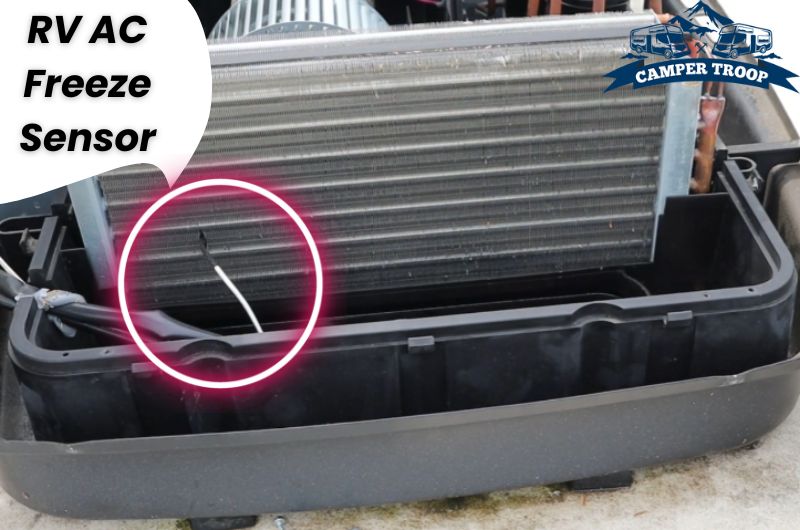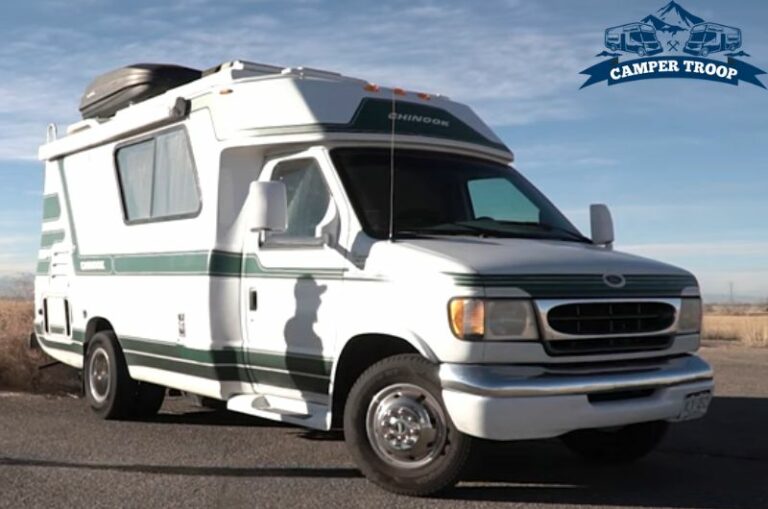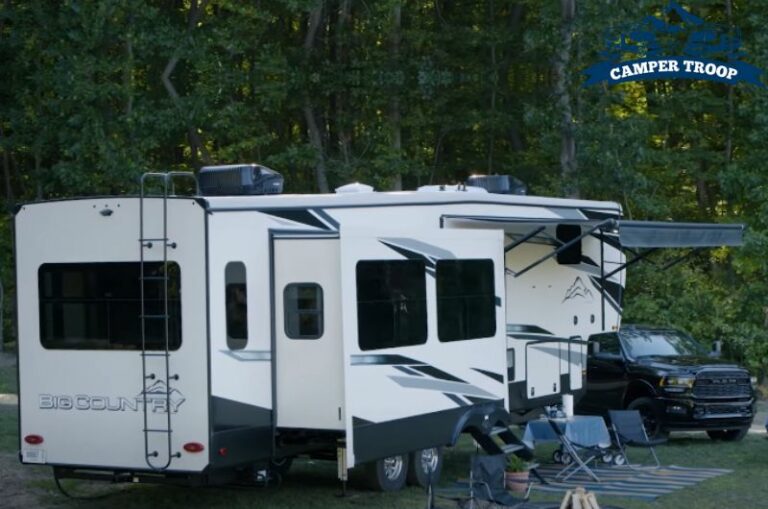RV AC Freeze Sensor Location [Complete Guide to a Freeze Sensor]
Suppose, your RV AC freeze sensor is acting up and causing serious problems for the RV. but you have no idea where exactly this sensor actually is in your RV. In order to diagnose the issue or for maintenance purposes, it is vital for you to know the location of the sensor.
The RV AC freeze sensor is commonly located halfway in the middle of the evaporator coils. It is often found on the left side of the AC unit. Very rarely, some Furrion freeze sensors could also be placed beside the fan or the air filter.
Let’s get to know about the RV AC freeze sensor working conditions and its types. We have also informed you how you can find out about the malfunctions of this sensor and how to replace it.

Two Common Types of RV AC Freeze Sensors
The RV AC freeze sensor is a type of temperature sensor. This sensor is categorized as a thermistor, the resistance of which is dependent on the temperature.
RV AC freeze sensors don’t really have much variety. The widely produced AC freeze sensors mainly belong to two leading companies- Domestic and Furrion.
Based on the separate and vast company production of the sensors, we can conclude they are two of the most common types.
Read Also: 6 Reasons Why Does RV AC Compressor Start and Then Stop
Dometic RV AC Freeze Sensor
Dometic RV AC freeze sensors are considered to be the most reliable options for freeze sensors on the market. These sensors detect when the evaporator coils are about to freeze and prevent it.
Moreover, Dometic AC freeze sensors can keep a tab on the air conditioning cycle and ensure that it is going well. They’re famous for delivering maximum performance and reliability.
Dometic RV AC sensors are made from premium materials at an affordable price. The sensor kit comes with a range of accessories, including air filters and air distribution components. It is very easy to install with the manual.
The location for Dometic AC freeze sensors should be on the left side of the AC. Remove the AC cover and access the internal components.
The sensor should be on the inside or outside fin of the coils. The reason for this placement is because this is the best location to get the coil temperature readings at any time.
Read Also: Adding Second AC to 50 Amp RV: A Complete DIY Guide
Furrion RV AC Freeze Sensor
Furrion RV AC freeze sensor is the second type of the sensor which is found inside the units of AC made by the same company. These sensors function a bit differently than the Dometic RV AC freeze sensor.
Most of the Furrion AC freeze sensor works by passing the air though a fan. The sensor inspects the air blown through the air conditioner fan and detects the temperature.
So, to keep up with the environmental temperature fluctuations, it comes with multiple fan settings.
The Furrion AC freeze sensor is connected to the room sensor in the AC unit. When they’re attached together, they’re both usually placed by the AC filter. Otherwise, Furrion AC freeze sensors are often located by the fan of the AC unit.
Read Also: RV AC Unit Humming But Fan Not Running – Why & How To Fix?
Where Is an RV AC Freeze Sensor Located?
The exact location of an RV AC freeze sensor is not known by all. This sensor is located inside the main AC unit of the RV air conditioner. The sensor is very small and looks a lot like a probe with connecting wires to it.
Locate the evaporator coils inside the RV main AC unit first. The RV AC freeze sensor will be placed halfway up in the middle of these evaporator coils. They’re connected to the evaporator coils with the help of a thin cable or wire.
The sensor is placed in that position so that it can get accurate temperature readings from the evaporator coils. A lot of the time, moving this sensor to a new location other than by the coils solves AC unit freezing problems.
Read Also: How to Solve RV AC Clicks But Won’t Turn On Problem?
How to Replace an RV AC Freeze Sensor?
A damaged RV AC freeze sensor is no help, as it won’t exactly detect when the coils are freezing. So, you will continuously have the AC freezing up problem.
The quick and simplest solution is to replace the bad freeze sensor with a new one. You can do this replacement at home with only a drill and a Phillips bit. Follow these steps to safely remove and replace the AC freeze sensor in your RV AC unit:
- Firstly, remove the cover plate from the air distribution box by pushing the sides of the plate.
- Push the filter tabs outside to remove the AC filters from the AC.
- Use a screwdriver or drill to remove the screws from the air distribution box.
- Completely remove the air distribution box from the AC unit.
- Make sure the harness connected to the box and controller is disconnected as well.
- You will find the AC freeze sensor right between the evaporator coils. Take the sensor carefully from the controller.
- Connect the new AC freeze sensor to the controller.
- Then, connect the other end of the sensor to the middle or top of the evaporator coils securely.
- Reconnect the controller harness to the air distribution box and screw it back on.
- Don’t forget to reattach the AC filter and the cover plate back on.
Read Also: RV AC Soft Start Vs Easy Start Kit | Which One is Worth it?
Common Symptoms of an RV AC Freeze Sensor Malfunctioning
When the RV AC freeze sensor starts malfunctioning, it will be very noticeable to you. As the sensor is one of the most inevitable parts of the AC unit, it affects the functions of the AC significantly.
You can realize that the freeze sensor is causing problems by diagnosing the symptoms your AC shows. The common symptoms of the RV AC sensor malfunctioning are-
- The AC doesn’t stop when the temperature reaches the set temperature that you have chosen on the thermostat.
- Air conditioning cycle randomly turns on and off, not following the temperature settings on the thermostat.
- Cool air keeps blowing past the evaporator coils, making the coils freeze up.
- Your RV interior becomes too uncomfortably cold despite setting a boundary temperature.
- The monthly power bills become too high which is unusual.
FAQs.
Let’s get to know more about the RV AC freeze sensor and its location inside the AC unit.
What are the common RV AC freeze sensor defects?
A defect in the RV AC freeze sensor can make the thermostat turn on and off on its own. Another common defect of freeze sensors happens due to dislocation of the sensor. The AC unit works in irregular cycles because of this.
How much does an RV AC freeze sensor cost?
A RV AC freeze sensor only costs about $30-$50 in the market. Since you can do the easy replacement by yourself, it won’t cost you any labor fee. These sensors also come with an accessory kit with them within this affordable price.
Conclusion
So, the default location of the RV AC freeze sensor is in the middle of the coils. When the sensor malfunctions, changing its location has seemed to help a lot of the users.
However, it is best to contact a HVAC professional and get the freeze sensor checked up thoroughly before moving it elsewhere.
If the parts of the sensor are defected, getting a new one is the most affordable and easiest fix for it.
Read Also: Ducted vs. Non-Ducted RV AC: What Should Be Your Choice?

Zayan is an accomplished author and a go-to expert for all things RV and camper-related. With a passion for adventure and a knack for problem-solving, he has spent years exploring the open road and fine-tuning his knowledge of recreational vehicles.
Zayan’s writing is a testament to his expertise, offering readers practical solutions to common RV dilemmas. Whether it’s troubleshooting mechanical issues, optimizing space, or planning the perfect road trip, Zayan’s insightful advice and engaging storytelling make him an invaluable resource for both seasoned travelers and newcomers to the world of RVing.





![How to Replace an RV Shower Pan? [Step By Step Process]](https://campertroop.com/wp-content/uploads/2023/01/How-to-Replace-an-RV-Shower-Pan-768x509.jpg)
